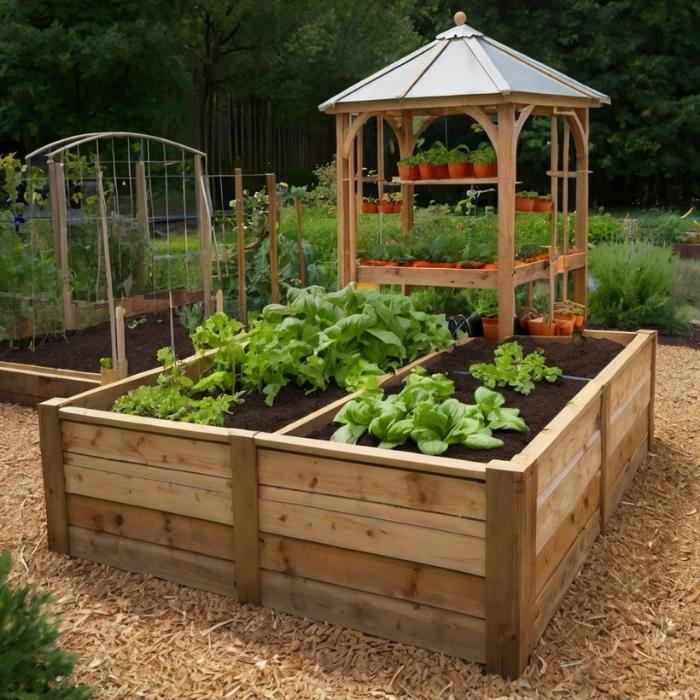Introduction: Small Veggie Garden Ideas
Transforming a small space into a thriving vegetable garden is easier than you think! Whether you have a tiny backyard, a balcony, or even just a sunny windowsill, there are endless creative ways to grow your own fresh produce. Small veggie garden ideas are all about maximizing your space with smart design, compact plants, and efficient growing techniques. Not only can a small vegetable garden provide delicious, homegrown food, but it’s also a rewarding way to connect with nature and boost your well-being. Let’s explore how you can create a lush, productive veggie haven, no matter how limited your space is!
Small veggie garden ideas
Creating a vegetable garden in a limited space can be both rewarding and enjoyable. Whether you have a small backyard, a balcony, or even just a windowsill, there are numerous ways to cultivate fresh vegetables. Here are some innovative ideas to help you maximize your gardening potential.
1. Container Gardening
Container gardening is an ideal solution for those with minimal space. You can use pots, buckets, or even repurposed containers to grow a variety of vegetables. The key is to choose the right size for your plants. For instance:
- Cherry Tomatoes: Requires at least a 12-inch deep pot.
- Chives: Thrives in containers that are 6 to 8 inches wide and 6 inches deep.
This method allows you to place your plants where they can receive adequate sunlight—ideally at least six hours of direct sun each day. Additionally, container gardens are easier to manage as they reduce the risk of weeds and pests, making them perfect for beginners12.
2. Vertical Gardening
When floor space is limited, consider growing vertically. This approach utilizes trellises, wall planters, or hanging pots to maximize your garden’s footprint. Here are some ideas:
- Trellises: Ideal for climbing plants like cucumbers, peas, and tomatoes. They not only save space but also add an aesthetic element to your garden.
- Wall Planters: Attach planters to fences or walls for herbs and leafy greens.
Vertical gardening can significantly increase your yield without requiring more ground space34.
3. Keyhole Gardens
A keyhole garden is a circular raised bed with a composting area at its center. This design allows you to grow a variety of vegetables while continuously enriching the soil with nutrients from kitchen scraps. It’s particularly useful in small spaces as it maximizes growing area while simplifying maintenance. The compost bin provides ongoing nourishment for the plants, ensuring healthy growth throughout the season3.
4. Salad Garden
A salad garden is perfect for those who enjoy fresh greens daily. You can grow compact varieties of lettuce, spinach, radishes, and green onions in a small area. Here’s how you can set it up:
- Choose Your Greens: Select fast-growing varieties that can be harvested multiple times throughout the season.
- Utilize Space Efficiently: Plant in rows or clusters to make the most of your limited area.
This type of garden not only provides fresh ingredients for salads but also encourages healthy eating habits15.
5. Herb Spiral
An herb spiral is a vertical garden design that allows you to grow various herbs in a compact space. The spiral shape creates microclimates that cater to different plant needs—some herbs prefer more moisture while others thrive in drier conditions. This design is not only functional but also visually appealing, making it an excellent addition to any small garden2.
6. Dwarf Fruit Trees
If you’re interested in growing fruit as well as vegetables, consider dwarf fruit trees. These trees are bred to stay small yet produce full-sized fruits. They can be grown in pots or small garden beds and provide delicious fruits without taking up much space. Popular choices include:
- Dwarf Apple Trees
- Dwarf Peach Trees
- Dwarf Citrus Trees
These trees can also serve as ornamental features in your garden5.
7. Companion Planting
Companion planting involves growing different plants together that benefit each other in some way—be it pest control, nutrient enhancement, or space efficiency. For example:
- Planting marigolds alongside tomatoes can deter pests.
- Basil planted near peppers can enhance their flavor.
This strategy not only maximizes your space but also promotes a healthier garden ecosystem4.
8. Raised Beds
If you have a bit more room but still want to keep things manageable, consider building raised beds. These structures allow for better soil control and drainage while keeping weeds at bay. You can customize the size based on your available space; even a small 4×4 foot raised bed can yield an impressive harvest if planted wisely.
9. Succession Planting
To make the most of your small garden throughout the growing season, practice succession planting. This technique involves planting new crops as soon as previous ones are harvested, ensuring continuous production without leaving any gaps in planting.For example:
- After harvesting early spring crops like radishes, replant with summer crops such as beans or cucumbers.
This method maximizes yield from limited space and keeps your garden productive year-round34.
10. Utilize Edible Landscaping
Incorporate vegetables into your existing landscape design by using edible plants as ornamental features. For instance:
- Use kale or Swiss chard as colorful border plants.
- Plant flowering herbs like chives or nasturtiums for both beauty and flavor.
This approach allows you to enjoy the aesthetic appeal of your garden while still producing food25.
Conclusion
Creating a small veggie garden is entirely feasible with thoughtful planning and creativity. By utilizing container gardening, vertical spaces, and clever designs like keyhole gardens and herb spirals, you can enjoy fresh produce regardless of your available area. Implementing these ideas not only enhances your home environment but also contributes to sustainable living through homegrown food production. Happy gardening! Companion Planting: Boost Your Garden’s Health and Yield

